Research
Lab & Archival Research
Cherokee Trail of Tears
The Cherokee Trail of Tears (TOT) is associated with the forced removal of the Cherokee people of Tennessee, Georgia, North Carolina, and other parts of the Southeast to the western United States in the late 1830s. From 1837 to 1839, thousands of Cherokee traveled through southern Illinois on what was known as the Golconda-Cape Girardeau Trace (now Illinois Route 146). Traveling on foot, horseback, and in wagons, the Cherokee camped along this road, bought supplies from settlers and tavern keepers, and buried those who died along this route. In 2013, the CAI engaged in three separate Trail of Tears–related projects for three separate agencies—the National Park Service (NPS), the USDA Forest Service, and the Illinois Historic Preservation Agency (IHPA).
Location of Illinois Section of Trail of Tears
Image: Map of Trail of Tears across the United States
Information Sources:
- Illinois State Archives, Illinois Public Domain Land Tract Sales URL: www.ilsos.gov/isa/pubdomsrch.jsp
- 30-Meter Digital Elevation Model (DEM), Illinois. URL: clearinghouse.isgs.illinois.edu/data/elevation/surface-elevation-30-meter-digital-elevation-model-dem
- Illinois PLSS county, state and land section. URL: http://isgs.illinois.edu/plss
The project we conducted for the NPS in 2012–2013 consisted of an archival and historical study of the types and number of TOT-related sites in southern Illinois associated with the Cherokee Removal. Such properties included taverns, mills, residences, stores, ferries, cemeteries, and campgrounds. We examined the distribution of the above properties within a 10-mile wide corridor (five miles north and five miles south) of Route 146, the modern version of the trail that extended for 55 miles from Golconda on the Ohio River in the east to several ferry locations on the Mississippi River in the west. The results of this research were used to create a GIS database showing the distribution of cultural properties in both tables and figures (see below). A total of 545 cultural and 31 natural (springs) properties were located within the corridor. Of these, 414 were mappable as to location. Thirty-eight of these sites have associated oral history or written documents that link them to the Trail of Tears. Fifteen of these sites could be identified to specific location, while 23 could be located in only a general sense.
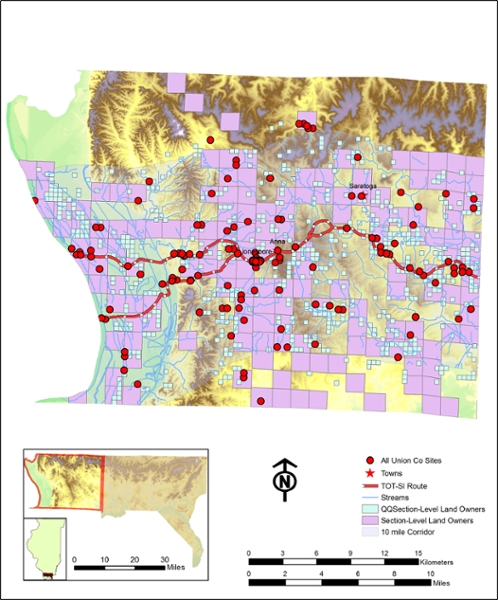
GIS map of 1830s property owners along the Trail of Tears in Union County, Illinois.
In the spring of 2013, the CAI assisted Shawnee National Forest archaeologists in the testing of two sites—11U316 and 11U615—located on Forest Service land along the southern branch of the trail that once led to a ferry used by the Cherokee to cross the Mississippi River and enter into Missouri. Indications that these sites potentially were associated with the Cherokee TOT included that one (11U316) possessed a spring, which could have supplied water to Cherokee emigrants, while the other (11U615) was known to have produced an early nineteenth-century smoking pipe manufactured by Moravian missionaries for trade to the Cherokee and other southeastern Native American peoples. The field crews for both sites consisted of volunteers enrolled in the Forest Service’s “Passport in Time” volunteer archaeology. Testing of site 11U615 recovered pre-1820 green shell edged creamware ceramic flatware sherds. This indicated that the spring at the site was in use in the early 1800s and potentially could have represented a stopping point for the Cherokee to obtain water for themselves and their animals. Archaeological testing of site 11U316 failed to recover additional early 1800s artifacts similar to the Moravian smoking pipe but did encounter the remains of a substantial prehistoric Mississippian period (AD 1000–1500) village that contained subsurface features.

Passport in Time volunteers at site 11U615.
In August 2013, the CAI conducted investigations for IHPA at the Bridges Tavern site in Johnson County, which is located directly on the Trail of Tears.
Crawford Farm Lead
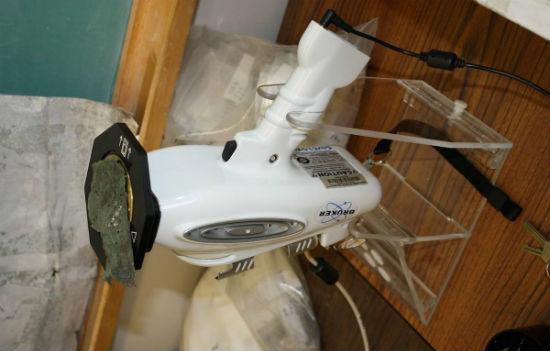 Interdepartmental collaboration: The Crawford Farm site (11Ri81) represents the ca. 1780-1815 location of the historic Sac village of Saukenauk in northwestern Illinois.
Interdepartmental collaboration: The Crawford Farm site (11Ri81) represents the ca. 1780-1815 location of the historic Sac village of Saukenauk in northwestern Illinois.
 The University of Illinois field school recovered a large artifact collection from the site in the 1950s and early 1960s prior to its destruction by a highway construction project in 1963. Reanalysis of the Crawford Farm artifact collection in 2014-2015 by Southern Illinois University (SIU) archaeologists identified a perforated rectangular copper kettle scrap interpreted as representing a possible copper sieve for lead shot production.
The University of Illinois field school recovered a large artifact collection from the site in the 1950s and early 1960s prior to its destruction by a highway construction project in 1963. Reanalysis of the Crawford Farm artifact collection in 2014-2015 by Southern Illinois University (SIU) archaeologists identified a perforated rectangular copper kettle scrap interpreted as representing a possible copper sieve for lead shot production.
To our knowledge, this artifact type has not been previously identified, leading us to use portable X-ray fluorescence (PXRF) and scanning electron microscopy (SEM) to confirm our observations. Interpretation is that melted lead in the kettle would drop through the holes into a bucket of water to form lead shot.
The results of this study, although limited, point out the usefulness of recent methodological advances such as PXRF in historic artifact analysis and identification.
Mastodons in Southern Illinois?
The answer is an emphatic first-time YES for Jackson County. In a collection recently donated to the Center for Archaeological Investigation, there was a most intriguing find, a partial mastodon tibia which is the first of its kind to be recovered in Jackson County, Illinois.
The bone was recovered from a rock shelter by amateur collectors over four decades ago. In the hands of CAI researchers under the direction of Dr. Mark Wagner, the mastodon bone is now undergoing state-of-the-art analysis to answer important questions about how and when, exactly, it came to be deposited in a rock shelter here in southern Illinois. Making use of the university’s new portable X-ray Florescence analyzer, CAI researchers recorded data to determine the origin of dark stains observed on the bone, finding that they consisted primarily of manganese.
This finding resolves one critical question: where did the stains come from? The pXRF data confirms that the stains resulted from the bone’s deposition in a watery environment, rather than the result of human activities such as burning. The bone has recently been delivered to the Illinois State Museum, where ISM paleontologists will determine whether or not enough collagen remains to conduct c14 dating.
The CAI received a grant from the Illinois Association for Advancement of Archaeology, a member of the Society for American Archaeology Council of Affiliated Societies whose mission is to unite all persons (amateurs, professionals, students and educators) interested in the archaeology of Illinois, to conduct radiocarbon analysis to determine the date of the mastodon bone and further our understanding of how and when the bone came to rest in the rock shelter.
Mound City Naval Base
Civil War Research: Mound City Naval Base – 2013
The CAI is currently creating a GIS database for the U.S. naval base (1862–1872) at Mound City, Illinois, on the Ohio River. Established in 1862, the naval base was the home of the U.S. Mississippi River Squadron.
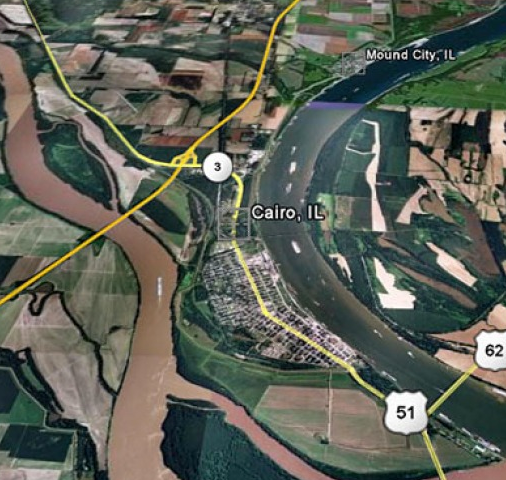
Comprised of over 200 ironclads, timberclads, hospital ships, transports, and other vessels, Mississippi River Squadron, under the commands of Commodore Foote and Admiral David Dixon Porter, was instrumental in breaking the Confederate stranglehold on the Mississippi, Tennessee, and Cumberland Rivers.

The Mississippi River Squadron off Mound City, with Admiral Porter’s flagship Blackhawk (far left) in the lead.
The boats of the Mississippi River Squadron fought in a number of the most famous engagements in the west, including the battles of Belmont, Ft. Donelson, Ft. Henry, Island No. 10, and Vicksburg.

The ironclad USS Cairo, which was constructed at Mound City.
The naval base itself consisted of a shipyard or marine ways, foundry, marine barracks, supply offices, hospital, and other facilities. All of these structures, with the exception of the marine ways, have long since vanished. Using a series of Civil War and later maps, photographs, charts, and other documents, Ph.D. student Go Matsumoto (CAI, SIU Anthropology Department) has constructed a GIS database for Mound City that identifies the locations of the naval yard and other Civil War–era facilities as well as a now-vanished very large prehistoric mound that gave Mound City its name.
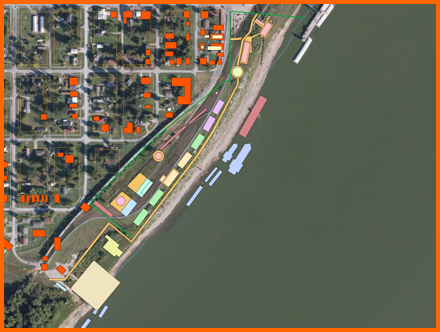
GIS overlay of Mound City showing locations of Civil War–era buildings (red),
naval yard facilities (light colored blocks on shore), and mooring stations
of Civil War vessels in the Ohio River (light colored blocks in water).
Through the construction of this database, we were able to identify several areas of the naval base that could potentially be investigated through archaeology. We also were able to identify the mooring station of Admiral Porter’s flagship, the Blackhawk, which accidentally burned during the last week of the war while anchored at Mound City. We are hopeful that Go’s study will be a first step in the further investigation of this nationally important Civil War site.
Planned Tasks
- Look for available resources (e.g., paper maps, air photos, and satellite images)
- Choose one of them as the base map
- Scan, georeference, and superimpose all of the map data over the base map in a GIS database
Complications: - None of our old paper maps have necessary information (e.g., x-y coordinate values, datum, and coordinate system).
Mound City GIS database protocol.

 Dr. Jan Simek (white hat) and Doug Kosik (CAI) conducting PXRF analysis of possible historic period paintings at the Parsons site in southern Illinois.
Dr. Jan Simek (white hat) and Doug Kosik (CAI) conducting PXRF analysis of possible historic period paintings at the Parsons site in southern Illinois. Parsons site pictograph
Parsons site pictograph
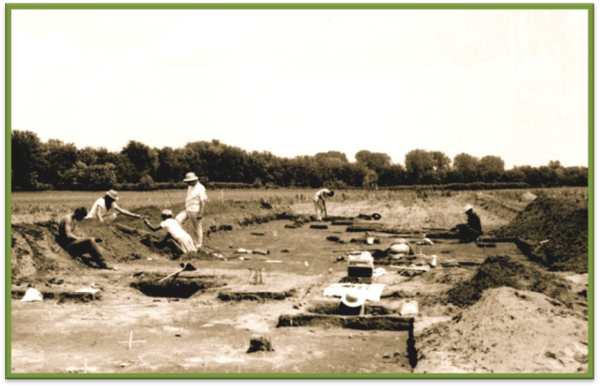
 The artifacts, excavation forms, maps, and other records associated with the U of I excavations are currently on loan to the CAI for use in completion of the Crawford Farm site report. The CAI staff have completed the artifact analyses, with the entire report, which will be made available to other researchers and the general public as part of the ISAS publication series, anticipated in 2014.
The artifacts, excavation forms, maps, and other records associated with the U of I excavations are currently on loan to the CAI for use in completion of the Crawford Farm site report. The CAI staff have completed the artifact analyses, with the entire report, which will be made available to other researchers and the general public as part of the ISAS publication series, anticipated in 2014.

 Image at left: Bridges Tavern, ca. 1934
Image at left: Bridges Tavern, ca. 1934